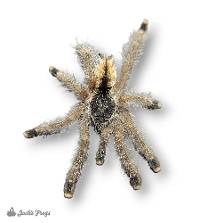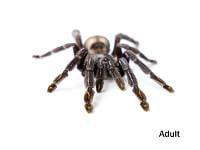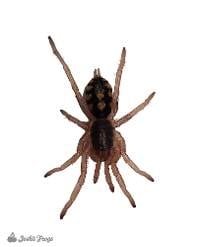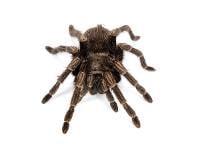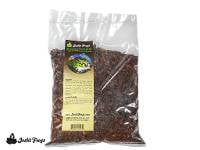Josh's Frogs
Mahogany Tree Tarantula- Tapinauchenius plumipes | 1 inch (Captive Bred)
Mahogany Tree Tarantula- Tapinauchenius plumipes | 1 inch (Captive Bred)
$49.99 0.0 out of 5 stars
(0)
0.0 out of 5 stars
(0)About This Product
Environmental Caution:
When a damp environment has too little air circulation, this can lead to an anaerobic environment. Where the typical aerobic bacteria helps keep certain types of waste from building up, they are instead replaced by anaerobic bacteria whose waste is more likely to be toxic and harmful. This is often accompanied by a strong swampy smell.
To guard against anaerobic environments, it is important to monitor and control moisture in the environment as well as air quality. One way to maximize both is to have plentiful live plants as the byproduct of photosynthesis is oxygen and water. Springtails can help keep the substrate aerated and break down waste so that the beneficial bacteria can more easily turn it into plant food.
Defining Characteristics:
- The Violet Tree Spider and the Purple Tree Spider were both synonymized with the Mahogany Tree Spider when it was decided that they were all the same species. This is why these Mahogany Tree Spiders will grow up to have a purple sheen.
- This is a small arboreal species, only growing to 3-4 inches
Name: Tapinauchenius plumipes is currently known as the Mahogany Tree Spider. The species epithet plumipes means ‘feathered feet’.
Recommended Enclosure Size & Setup: Tapinauchenius plumipes is an arboreal species, meaning the enclosure should be taller than it is long. The recommended enclosure height is at least 3 times the spider’s diagonal leg span, and the other dimensions should not be less than two times the spider’s diagonal leg span. The enclosure will need to be upgraded as the animal continues to grow.
4-5 inches of substrate will help the terrarium retain humidity while still allowing for this species to have its high ventilation requirements. ABG mix, coco cradle, or Dig-It are good substrate options, but our Pet Bug Team prefers ABG all the way!
They will benefit from a variety of terrarium furniture as well to climb on and foliage to hide behind. Live plants can be beneficial to air quality.
Temperature (°F): This species thrives in the mid 70s to low 80s, so a temperature close to 80° is ideal. Temperatures regularly dipping below 65 or spiking above 85 degrees should be avoided.
A reliable thermometer is strongly recommended.
Humidity: These spiders thrive in a humid environment, so the recommended ambient humidity should stay between 60 and 75%. This can be achieved by making sure the substrate is always slightly moistened. Depending on your location, you may need tools such as a humidifier to maintain this environment.
The enclosure sides and decor should be spritzed at least lightly around twice a week to provide your animal droplets to drink from and keep humidity up. Do not spray your spider directly.
A hygrometer is a great way to monitor the humidity for your animal and see any needed adjustments.
Size: These tarantulas will be at least 1 inch in diagonal leg span at time of sale. Females reach 3-4 inches, while males are even smaller.
Age: These spiders are about 1 year old at time of sale. Females can live up to 10 years while males generally only reach 3-4 years.
Feeding: These spiders are currently eating two to three 1/4 inch crickets, once a week. There are a variety of appropriate prey items that you can offer, such as roaches, waxworms, black soldier fly larvae, hornworms, and silkworms. Consider feeding your prey items with our gutload formula to give your pet well-rounded nutrition.
We recommend that the prey items not be much longer than the tarantula's “head” is wide. Larvae are an exception—our larvae are harmless. Since they are very high in fat, they're not the best staple diet, however they make a great weight gain supplement.
Remove uneaten prey items after 24 hours, these may stress your animal out or endanger the spider during molting. Never attempt to feed a freshly molted tarantula less than a week after their molt to prevent injury to the spider. Depending on its age, the hardening process could take anywhere from 48 hours all the way up to a week.
Sexing: Due to age, Tapinauchenius plumipes sold by Josh’s Frogs are sold as unsexed.
Color/Pattern: Babies have stripy patterns on their abdomen and light legs with dark bands at the end. As adults, they are a uniform shiny brown with light to strong iridescent blue or purple that shines in the right light.
Social Behavior: Tapinauchenius plumipes is not a sociable animal and should be housed as an individual. Attempts at cohabitation can result in cannibalism.
This species is shy. They tend to build a web tent where their driftwood hits the ground and come out infrequently, other than to feed.
T. plumipes are nervous animals and are quick to bolt. A catch cup should be kept handy when opening this spider’s habitat.
Natural Range: Tapinauchenius plumipes can be found in the wild in Guyana, Suriname, French Guiana, and Brazil.
History in the Hobby: This species has rarely been available as Tapinauchenius plumipes. Two recent junior synonyms (Tapinauchenius violaceus and Tapinauchenius cupreus) have been available, mostly wil caught, for the last 15 years or so.
Links of Interest:
- Arachnoboards: A community of spider enthusiasts that will be able to or have already answered almost any question you can think of with regards to tarantulas.
Shipping
After placing an order containing a live animal, you will receive a scheduling email containing our JotForm scheduling link to schedule your new pet's delivery date.
With this scheduling link, you will be able to schedule your order's delivery up to 30 days in advance. You will be able to choose a date of delivery for Tuesday-Saturday (Saturday arrival depends on the carrier's service availability) with the estimated time of arrival generally being 12pm, or 4:30pm for more rural areas. Overnight lows must be above 40°F to ship directly to you (or above 30°F for FedEx Ship Center pickups) as well as below 90°F by estimated time of arrival.
If you require further assistance, or prefer to talk to one of our Customer Service agents, please feel free to reach out to our [email protected] email or our phone line 1-800-691-8178.
Other Customers Also Bought
Customer Reviews
0.0 out of 5 stars
Review data
5 star reviews
- 0%
4 star reviews
- 0%
3 star reviews
- 0%
2 star reviews
- 0%
1 star reviews
- 0%

